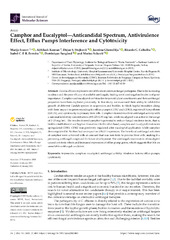Приказ основних података о документу
Camphor and eucalyptol—anticandidal spectrum, antivirulence effect, efflux pumps interference and cytotoxicity
| dc.creator | Ivanov, Marija | |
| dc.creator | Kannan, Abhilash | |
| dc.creator | Stojković, Dejan | |
| dc.creator | Glamočlija, Jasmina | |
| dc.creator | Calhelha, Ricardo C. | |
| dc.creator | Ferreira, Isabel C.F.R. | |
| dc.creator | Sanglard, Dominique | |
| dc.creator | Soković, Marina | |
| dc.date.accessioned | 2021-06-03T11:12:21Z | |
| dc.date.available | 2021-06-03T11:12:21Z | |
| dc.date.issued | 2021 | |
| dc.identifier.issn | 1422-0067 | |
| dc.identifier.uri | https://doi.org/10.3390/ijms22020483 | |
| dc.identifier.uri | https://radar.ibiss.bg.ac.rs/handle/123456789/4230 | |
| dc.description.abstract | Candida albicans represents one of the most common fungal pathogens. Due to its increasing incidence and the poor efficacy of available antifungals, finding novel antifungal molecules is of great importance. Camphor and eucalyptol are bioactive terpenoid plant constituents and their antifungal properties have been explored previously. In this study, we examined their ability to inhibit the growth of different Candida species in suspension and biofilm, to block hyphal transition along with their impact on genes encoding for efflux pumps (CDR1 and CDR2), ergosterol biosynthesis (ERG11), and cytotoxicity to primary liver cells. Camphor showed excellent antifungal activity with a minimal inhibitory concentration of 0.125–0.35 mg/mL while eucalyptol was active in the range of 2–23 mg/mL. The results showed camphor’s potential to reduce fungal virulence traits, that is, biofilm establishment and hyphae formation. On the other hand, camphor and eucalyptol treatments upregulated CDR1; CDR2 was positively regulated after eucalyptol application while camphor downregulated it. Neither had an impact on ERG11 expression. The beneficial antifungal activities of camphor were achieved with an amount that was non-toxic to porcine liver cells, making it a promising antifungal compound for future development. The antifungal concentration of eucalyptol caused cytotoxic effects and increased expression of efflux pump genes, which suggests that it is an unsuitable antifungal candidate. | |
| dc.publisher | MDPI AG | |
| dc.relation | info:eu-repo/grantAgreement/MESTD/inst-2020/200007/RS// | |
| dc.relation | FEMS-GO-2017-015 | |
| dc.relation | UIDB/00690/2020 | |
| dc.rights | openAccess | |
| dc.rights.uri | https://creativecommons.org/licenses/by/4.0/ | |
| dc.source | International Journal of Molecular Sciences | |
| dc.subject | Antifungal activity | |
| dc.subject | Camphor | |
| dc.subject | Cytotoxicity | |
| dc.subject | Efflux pumps | |
| dc.subject | Eucalyptol | |
| dc.subject | Terpenoids | |
| dc.subject | Virulence factors | |
| dc.title | Camphor and eucalyptol—anticandidal spectrum, antivirulence effect, efflux pumps interference and cytotoxicity | |
| dc.type | article | en |
| dc.rights.license | BY | |
| dcterms.abstract | Иванов, Марија; Стојковић, Дејан; Гламочлија, Јасмина; Цалхелха, Рицардо Ц.; Санглард, Доминиqуе; Соковић, Марина; Ферреира, Исабел Ц.Ф.Р.; Каннан, Aбхиласх; | |
| dc.rights.holder | © 2021 by the authors. Licensee MDPI, Basel, Switzerland. | |
| dc.citation.issue | 2 | |
| dc.citation.volume | 22 | |
| dc.identifier.doi | 10.3390/ijms22020483 | |
| dc.identifier.pmid | 33418931 | |
| dc.identifier.scopus | 2-s2.0-85099118488 | |
| dc.identifier.wos | 000611346800001 | |
| dc.citation.apa | Ivanov, M., Kannan, A., Stojković, D. S., Glamočlija, J., Calhelha, R. C., Ferreira, I. C. F. R., et al. (2021). Camphor and eucalyptol—anticandidal spectrum, antivirulence effect, efflux pumps interference and cytotoxicity. International Journal of Molecular Sciences, 22(2), 1–14. | |
| dc.citation.vancouver | Ivanov M, Kannan A, Stojković DS, Glamočlija J, Calhelha RC, Ferreira ICFR, Sanglard D, Soković M. Camphor and eucalyptol—anticandidal spectrum, antivirulence effect, efflux pumps interference and cytotoxicity. Int J Mol Sci. 2021;22(2):1–14. | |
| dc.citation.spage | 1 | |
| dc.citation.epage | 14 | |
| dc.type.version | publishedVersion | |
| dc.identifier.fulltext | https://radar.ibiss.bg.ac.rs/bitstream/id/8477/ijms-22-00483.pdf | |
| dc.citation.rank | M21 |

